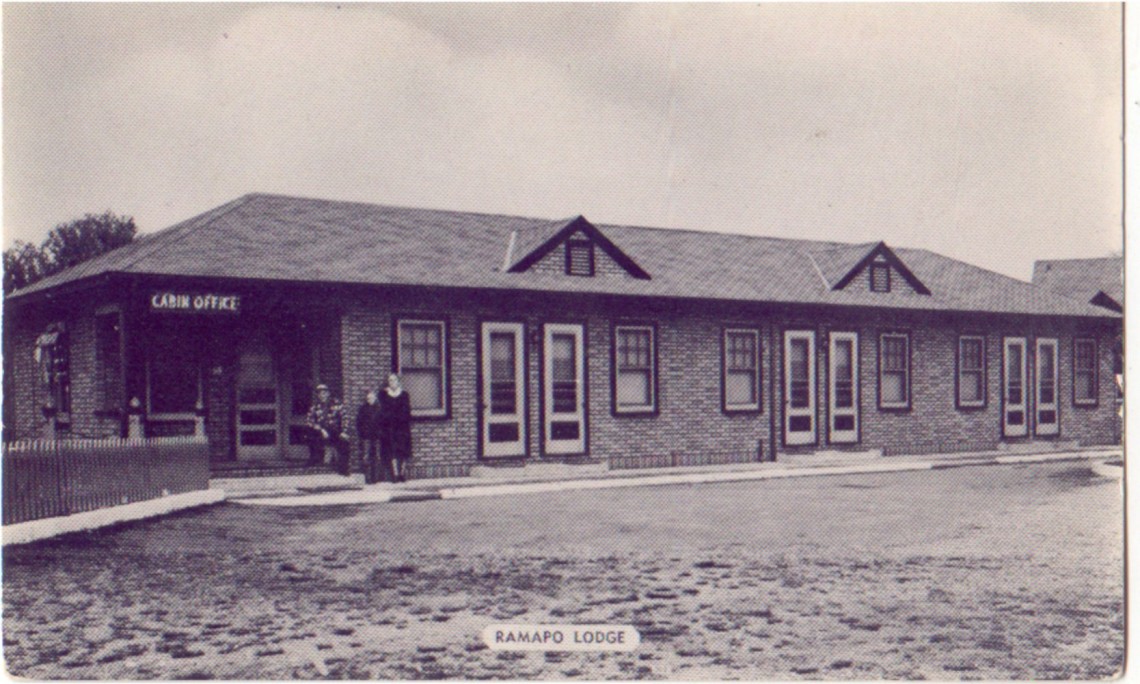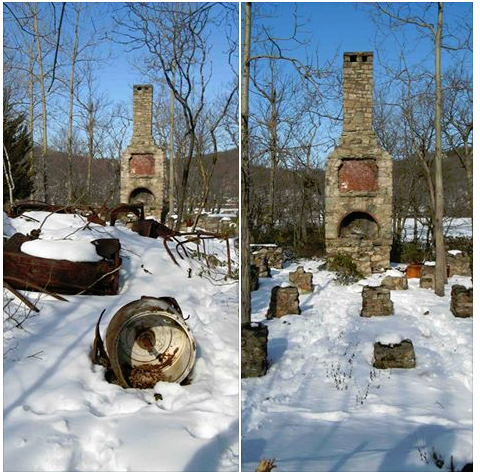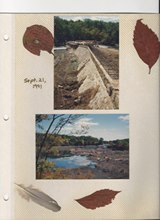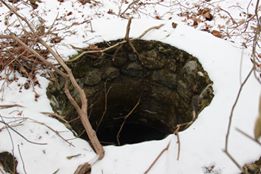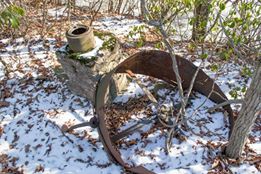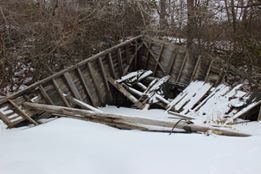The Lodge was on Ramapo Lake
Paul Neuman
December 26, 2014
These photos are of what remains of the house that stood on the island in Ramapo Lake. I haven’t been out there in a few years. You need a good cold snap before venturing over to it.
Does anybody have a photo of the house when it was standing? Was it part of the Van Slyke estate? When was it destroyed? I assume it was burned.
I seem to remember reading something years ago that the house was built as a safe haven, maybe from the flu pandemic of 1918 or a later public health crisis (TB, polio?). Of course I have no idea where I read this and have not been able to find any info on the house. The home did have some comforts; the carcasses of a refrigerator, washer, etc. can still be seen over there.
Hike into History
Ginny Chucka AKA ”FOXCROFT” on Fox Mountain
Take a hike. Depending on your tone of voice it can be good advice or a condescending suggestion. In this case it is very good advice because Oakland offers its residents a great opportunity to enjoy outdoor exercise, take in some beautiful scenery, and wander down wooded paths that lead you through local, regional and world history.
The hike detailed here starts just off Skyline Drive and is approximately five miles, start to finish. It will take you up through the Ramapo Hills to great vistas where you can visit the ruins of what has been called “The Oakland Castle”, “The Van Slyke Castle” or “Foxcroft”. Click here to go directly to the photos and details of the recent hike, but it will be much more fun knowing the story behind The Castle.
Just as Harriman State Park’s history is connected to its namesake’s railroad fortunes, the story of the Castle’s origin begin with trains. The land was originally purchased by Jacob Rogers, the son of Thomas Rogers who founded Rogers Locomotive in Paterson, NJ. Established in 1831, this company eventually built more than six thousand locomotives for railroads around the world. Jacob Rogers managed the company well into his seventies, but eventually delegated managerial responsibilities as he got older. Right before his death, in 1900, Rogers sold the company to a group of investors who were keen on keeping the company in the congested city. He died in 1901 leaving various trusts to heirs and the majority of his wealth to The Metropolitan Museum of Art in New York City.
The Metropolitan Museum of Art
The wooded land in the Ramapo Hills was left to his two grandsons in a trust, and upon their death the land would be deeded to The Museum. Unable to pay the taxes on the property, trustees for the estate entered into an agreement for the Museum to assume responsibility of the property, estimated to be worth $500,000. The Museum was to pay the estate $250,000, and the trustees would be responsible for providing the annuities required by the will for $500 to each grandson. The title to this property was added to the $5,000,000 already left to The Museum. As to be expected, lawsuits were filed, and the $250,000 was eventually set aside to be dispersed amongst an array of relations . The New Jersey Legislature, in a rare act of financial prudence, denied a request by The Museum to waive the five percent inheritance tax on the property in Oakland.
Having no need for the property, The Museum sold it to a New York stockbroker in 1905. Howard Frothingham was looking for a nice country retreat to escape the pressures of Wall Street. He was known as a very intense worker in an industry know for A-type personalities, and his nervous scurrying through the city streets in his car coined the parochial term of going about in “Frothingham’s way”. But Frothingham sold the property in the midst of an emotional breakdown. Diagnosed as suffering from exhaustion, Frothingham that year had two male nurses assigned to watch over him at his home in New York City. The precautionary measures proved a failure as Frothingham, on a cold February day in 1907, pushed off his aides and dove headfirst out the two-story window of his bedroom. He fractured his skull and never regained consciousness.
The Van Slyke Castle
A few uneventful years passed as the property exchanged hands and landed in the lap of another Wall Street figure, William Porter. It is Porter who is credited with building “The Van Slyke Castle”, and perhaps he should have called it the “Porter Castle” rather than “Foxcroft”. William Porter seemed to enjoy the home he built out in the country, and in May 1911 arranged for three friends to accompany him the weekend before his wife’s return from a European vacation. Chauffeured out to the Ramapo Hills, one can assume it was a special setting to be hidden away in nature with New York City so far in the distance. Like many a “boy’s night out”, there were most likely some fine cigars and scotch consumed that fateful weekend, and William Porter did not expect that it would be his last visit.
The party of stockbrokers were due back in the office, located in the Toy Building at 200 Fifth Avenue, by 9am Monday morning, but fate intervened that morning on Haledon Road just outside of Paterson. The chauffeur was passing a horse drawn cart of stones when the animal crossed the car’s path forcing the driver off the road. The car overturned and threw all the passengers, except Porter, out of the vehicle on to the soft ground; William Porter was pinned underneath. He remained conscious during the rescue efforts and was finally freed after a half hour’s efforts. His companions quickly arranged to transport the critically injured Porter to Paterson General Hospital.
Returning to America on the Lusitania
Porter’s wife, Ruth Halliwell Porter, was returning to America on the Lusitania, and relatives decided that they would not wire the ship but wait for her arrival before breaking the news of the tragic accident. The accompanying menu details the gourmet meal Ruth Porter was having while her husband, unknowingly, lay near death in Paterson , NJ. The Lusitania, as students of history may know, would be hit German torpedo in 1915 and be a contributing factor in the United States entering WWI in 1917. But back in 1911, “The Lucy” was the queen of the ocean, and would soon be joined by The Titanic which was just being promoted at that time.
The Oakland Journal was unable to verify if Ruth Halliwell Porter was rushed to the bedside of her second husband in time to bid him bon voyage on life’s greatest journey. William Porter, like Jacob Rogers, left behind approximately $5,000,000 dollars. Porter left behind a son and daughter from a previous marriage, and his will provided a 50% share for his daughter, and 25% each for his wife and son.
Having been widowed twice, Ruth Porter hoped that the third time would be a charm, and in 1913 announced her engagement to a well-known Manhattan attorney Warren Van Slyke. The couple had many good years together enjoying the high life and prestige their social standing allowed them. Van Slyke would serve as Assistant Chief of Naval Intelligence during the war, not an insignificant position when considering the menace of the German U-boats. He would later go on to represent claimants in their lawsuits against the German government in the sinking of the Lusitania. He was also a man fond of exotic travel which took him on safaris to Africa and French Indo-China. The latter trip lasted over a year and Van Slyke reported on his return, in April 1923, of meeting with an aborigine tribe with a vocabulary that consisted of just 500 words.
It was good for Van Slyke to make the trip when he did, because he too would die an untimely death. Almost two years to the day of his return from the French Indo-China safari, Warren Van Slyke died of complications from a gallstone operation at Roosevelt Hospital in New York City. Ruth Halliwell Porter Van Slyke was widowed for the third time.
Ruth Van Slyke never married again but continued to move in her established social circles traveling to the Caribbean and Europe depending on the season, and hosting dinner parties in New York City. She died at “Foxcroft” in 1940. The property was put up for sale by her estate in 1942.
The property was owned in the 1950s by a couple in the the midst of a bitter divorce and the property was abandoned during this period. In 1959, it was burned by vandals. In 1976, the State gained control of the property in it’s purchase of the Ramapo Mountain forest from the estate of Clifford F. McEvoy.
The Structure on the island was a fishing lodge
Kevin Heffernan I believe the structure on the island was in fact a fishing lodge as part of a private hunting and fishing club which owned the entire park property originally. It was burned down by vandals in the 1950s.
Pete Emmons Here’s an old postcard that might be of interest, undated.
Kevin Heffernan Correction: It originally was a guest house that was torched in 1978.
Paul Neuman Great postcard, thanks! The collapsed boathouse is still clearly visible. 1978, I just missed seeing it by a few years. Didn’t start hiking up there until the early ’80s. You can see from the historicaerial shots comparing 1971 to 1979 that something was there, then it wasn’t. Was it a Foxcroft guest house or one of the other residences?
Sue Proskey March The Decker family used to keep their sailboat moored near the boathouse. There was also a diving board on the point of the island. We would sit along the shoreline of the island sometimes when we ice fished up there.
Ginny Chucka Picture of the Boat house 23 years ago Sept. 1991
Ginny Chucka Dam repair 1991
Ron Romaine there was a house on the way up to the Van Slyke house that served as servant quarters back when Mrs Van slyke owned the house
Lee Williams The chimney standing looks like the fireplace that was in the main room of the island lodge. The lodge seemed to be specifically built for the NY investment group that Mr. MacEvoy was a part of. It had a large main hall surrounded by quite a few “member rooms” that were small and contained a bed, dresser and little else. They were all similar and gave the appearance of a hotel. I don’t remember how many there were, but they were for the private use of members to enjoy a weekend in the woods at one of the best fishing lakes anywhere. There was also a large kitchen and laundry facilities. The depression changed all that.
Ginny Chucka On the Island today…
Ginny Chucka The Well
Sue Proskey March That well needs a cover
Ginny Chucka It had lots of water in it….
Sue Proskey March very lucky no adventurer has accidentally fallen into it yet (or any animal)
Paul Neuman My friend and I were over there yesterday. The ice is nice and solid. You beat me to posting the very same pictures! We were wondering how deep the well is and how they moved the water from it. That little shed on the north end of the island is also mysterious. There is pipe going up to the house and a hose that evidently went into the water. Was there once a pump in the shed? Doesn’t seem to be any indication that there was power to it. We thought maybe the hose ran all the way under the lake to the old pumphouse but that doesn’t really seem to make any sense. We also checked out the remains of the boathouse, the old metal step ladder, and the mount for the old diving board on the south end. There is also this mysterious jumble of pipes away from the house, towards the south. Not a clue what might have been there.
Paul Neuman Next to the pipes
Paul Neuman Inside the shed
Sue Proskey March any possibility there may have been some sort of fire suppression system?
Ginny Chucka Paul Neuman I saw your footprints and the ice was nice and thick ,couple of guys ice fishing………….What left of the Boathouse……
Edward Seifert I was on the first arriving fire engine that night. (Oakland Engine 50, an FWD pumper) It was 7 degrees Fahrenheit. The glow from the fire was visible as we exited the Yawpo Avenue firehouse. Upon arrival, we had no water source…the ice was way too thick to allow for an ice auger. Since it took us 10-15 minutes to travel to the site, there was little anyone could do to save the structure. The structure was fully involved.. Since the island was actually located in Passaic County, the Wanaque FD was notified and we turned the incident over to their department.
Edward Seifert The house located just below Van Slyke castle was most recently occupied by Paul Korzinsky, owner of Paul’s Volvo Sales and Service on Goffle Rd. in Hawthorne. According to my sources, at some point in 2014, the new owner of Bear Run, located on Ramapo Lake, purchased the property. He also purchased the Butler property, located at the western edge of Ramapo Lake. Intent unknown.
Paul Neuman Thanks Ed for the informative posts. Do you remember what year the lodge burned? My understanding is Van Slyke burned in 1959. I wonder if the same arsonists were responsible for both fires?
Ginny Chucka Still looking but came across this…
Ramapo Lake is half in Wanaque half Oakland
The 120 acre Ramapo Lake is the centerpiece of Ramapo Mountain State Forest. Fish such as Largemouth Bass, Yellow Perch and Pickerel among other species are found in the lake. Ramapo Lake was originally a 25 acre pond known as Roten Pond. (“Roten” is Dutch for Muskrat). English translation corrupted “Roten” to “Rotten” Lake. The pond was later dammed to form the present Ramapo Lake AKA LeGrande
Ginny Chucka Nothing on the Island but found this article…..
Three children wandered from their home on a Thanksgiving Day, and becoming lost, they perished in the mountain
Paterson Ramblers at Oakland
June 9, 1907 [ the 3 Wyble children wandered from their home on a Thanksgiving Day, and becoming lost, they perished in the mountain]
The Paterson Rambling Club, accompanied by a number of invited guests, went by Susquehanna Railroad, Sunday, June 9th, 1907 to Oakland. Arriving at the station they were met by Amos W. Hopper, the mayor, with a number of the residents of the Borough of Oakland, who accompanied the Club on its ramble. . . .
West Oakland lies on the west side of the Ramapo River at the foot of the mountain of the same name, where there was a number of houses, one of them, “Shadowmont,” being the summer home of Mr. and Mrs. H. M. Carman, of this city.
The winding roadway from the station to the river, a distance of nearly a mile, affords magnificent views of the surrounding country, and when the bridge which spans the clear waters of the river was reached, their intersecting valleys, were reflected in the leisurely flow of the tranquil waters, exemplifying in many ways the meaning of old Bergen County’s name, “The place of many hills.”
Leaving the bridge, the roadway winds through a dense woodland, which has the fascinating adjunct of a lively brook, the waters of which run from one stone to another, murmuring a never ceasing song . . .
A short distance further on “Shadowmont” and the Morrison cottage were reached, where the Ramblers were greeted by Mrs. H. M. Carman and Miss Margaret E. Morrison. The views from these cottages baffle a description, both in extent and diversity, and the only way to get a full conception of their beauty is to take a ramble some pleasant day through the Ramapo valley at West Oakland. In the artistically arranged Morrison cottage the 38 Ramblers sat down to eat their lunch and drink their tea. What a lot of cheer there is in a cup of good tea to a weary Rambler, especially when it is served in such generous quantities by such gracious ladies as Mrs. Carman and Miss Morrison.
Extending a vote of thanks to the ladies for their generous hospitality, the ramble was continued to the residence of Frank Henn, who has charge of the Pliny Fink estate, and after pleasant greetings at this place were exchanged the walk was resumed up a most picturesque winding mountain roadway. About halfway up the mountain there is an opening in the forest growth which affords a magnificent view of Pompton, with its church spires and pleasant places of residence, as well as a great variety of the surrounding scenery, with many mountain peaks in the distance.
Near this point the old Cannon Ball Road is intercepted until the top of the mountain is reached, when Le Grand Lake appears in view. Looking down on this sheet of water, which lies in a rocky, tree-fringed basin on top of the mountain, many exclamations were heard of “Isn’t it grand?” when one of the Ramblers, less esthetic perhaps than the others, exclaimed, “Rotten.” No insinuation was meant, however, as the sheet of water on that part of the mountain was long known as “Rotten Pond.”
There has long been a supposition that the name of “Rotten” was given to the pond many years ago by an English geologist, who is said to have found the soil on certain approaches to it of such a porous or rotten nature that it was unsafe to venture on it. That characteristic, however, if it has an existence, ceased to prevail when the late Jacob S. Rogers raised the dam several feet higher, when the porous ground became part of the bed of the lake.
Another and probably more authentic version of how the name of “Rotten” came to be bestowed upon the pond is that in the early days when the Hollanders settled in that part of Bergen County they trapped many animals, among which were many muskrats, which had their haunts at the pond. In the Holland language the word “rat” in the singular, is spelled the same as in English, but in the plural it is spelled “ratten.” They went ratten to the pond, hence the corruption of the word into rotten. . . .
Cannon Ball Road
From the lake the Ramblers strolled some distance further on the historical Cannon Ball Road on which cannon balls were carted by mule and ox teams from the foundries at Pompton and Ringwood to the Hudson River, and though these days have long since passed into the yesterdays of time, yet an inspiration of those trying days which made this nation a free and independent people, lingers in the old ruts of this crude mountain roadway — lingers and lives to thatch all present joined in singing: . . .
From the old roadway the party was led for a mile and a half through a rocky wilderness of forest to a cluster of overhanging rocks where 37 years ago the 3 Wyble children wandered from their home on a Thanksgiving Day, and becoming lost, they perished in the mountain. Many of our older people will remember the wide-spread interest which attached to this sad event, the bodies of the children not being found until the latter part of the following extent that it inspired one of the Ramblers to pitch the key, in whi January, and some will probably recall the heroism displayed in that tragedy, the oldest boy being found in his shirt sleeves, having taken the coat from his own shivering body to wrap it around that of his youngest and more tender brother. . . .
And standing beside the rock where these children perished through the double tragedy of hunger and exposure, the Ramblers, with uncovered heads, sang most impressively, the hymn, “Near, My God, to Thee” and in all probability it was the first time that that, or the intonation of any other hymn, had been rendered at that memorable rock.
A quarter of a mile or so away a flat rock was pointed out, where the bodies of the children were placed to await their removal from the mountain. The afternoon was waning and the shadows of the great mountain had fallen on West Oakland when the Ramblers passed through many charming woodland and mountain scenes to the station.
Rydings, Joseph. 1934. Country Walks in Many Fields. Being Certain Choice Annals of the Paterson Rambling Club. Paterson, NJ: The Call Printing and Publishing Company.
Edward Seifert Outstanding find Ginny!!
Ron Romaine Frank Hen’s house sounds like it could be the Gate house in Pool Hollow & The Pliny fink Estate might be the Van Slyke estate- not surte, though
Paul Neuman Thanks for posting Ginny. I’ve tried to get that book but haven’t been able to find it at a reasonable price. Always wondered exactly where the children were found. I think the family was from Wanaque.
Ginny Chucka I wrote Michele. Buckley Island “hunting lodge” for men who were visiting the area.
Ginny – I reached out to Sue Shutte, Resource Interpretive Specialist at Ringwood State Park and here is the information she was able to provide to us: The remains of the building on the center island of Ramapo Lake are a bit of a mystery that I haven’t been able to fully confirm at this point. A bit of background: In the late 19th century (I don’t have an exact purchase date) Jacob Rogers, the son of the founder of the locomotive industry in Paterson, NJ, greatly increased the size of the lake by placing a stone dam across the south portion of it. His intent was to develop the property. But Rogers died in 1901 before he could do that and his will directed the property be given to the Metropolitan Museum of Art. The MET then sold it to Howard P. Frothingham in 1905. Frothingham was a financier and avid fisherman and was going to turn the area into a game preserve. He temporarily changed the name of Ramapo Lake to “Le Grande Lake.” One might assume because it had a certain air about it that would attract more wealthy vacationers from New York City rather than “Rotten Pond.” Frothingham, however, sold it two years later to Pliny Fisk, an associate, who wanted to establish a “Tuxedo Park-like community” on the property. in 1907 William Porter purchased additional land and then divided the property between two corporations: Ramapo Club and Ramapo Park. Fisk owned the lake and strip of land around it, and Porter owned the hilly woodland. The idea was to allow the future owners of homes on the hillside use of the lake. Porter built “Foxcroft” (also known as “Van Slyke Castle”), but after his death the plan was abandoned. Ramapo Club was merged with Ramapo Park in 1914. Clifford MacEvoy, wealthy developer and general contractor of the Wanaque Reservoir, gained control of the corporation in the early 1920’s. The State of NJ purchased what is now Ramapo State Forest from his estate in 1976. I have heard that the building on the island was a clubhouse of sorts. The first story I have heard was that it was a “hunting lodge” for men who were visiting the area. Now, whether that was during the time of Frothingham’s ownership of the area (he wanted it to be a hunting and game preserve) OR whether that was of the Fisk/Porter ownership (“Ramapo Club” was to be the lake area- was the building the “clubhouse” for the proposed development) OR was it part of Porter’s Foxcroft estate and he used it to entertain his male friends and guests, I don’t know. We haven’t been able to confirm any of these stories for certain. Most likely it was the last of these three theories, as there was very little construction on the property of various structures until the time of the Fisk/Porter ownership era. I have never heard the story about it housing individuals that were sick with tuberculosis and, based on the remote location and the relatively small size of the structure, I don’t think that would have taken place. Generally in the late 19th and early 20th century, individuals sick with tuberculosis were quarantined in hospitals or other medical facilities specifically built for that purpose and away from general patient populations. If you use google earth satellite maps, you can zoom in fairly close and see a distinct outline of the foundations and chimney, which is also very obvious from the shoreline at this time of year. I’m hoping the lake freezes enough this year to actually go out on the island and explore a little. I do not have a date on when that structure burned in a fire, only the date of when Foxcroft/Van Slyke Castle burned (1959). Michele Buckley, Supervisor Office of Communications & Visitor Services Mail Code: 501-04, PO Box 420 Trenton, NJ 08625-0420 609-292-2776 Michele.Buckley@dep.nj.gov
Ed Zindel Around the turn of the century (1891-1901), owner Jacob S. Roberts, a wealthy locomotive engineer from Paterson, NJ, built a dam across the Rotten Pond outflow to enlarge the size of the pond. Upon his death in 1901 Rogers willed his estate, valued at $6,000,000, to the Metropolitan Museum of Art. In 1905, the MET transferred Rotten Pond to financier Howard Frothingham who renamed it LeGrande Lake after his wife Maud LeGrande Frothingham. In 1906, Frothingham sold Rotten Pond to another financier named Pliny Fisk who then passed it to stock broker William Porter in 1908. Porter changed the name of the impoundment from LeGrande Lake to Ramapo Lake and established two corporations (The Ramapo Club and Ramapo Park) to accommodate sportsmen interested in buying land near the lake. In a 1909 deed, (which I have) he transferred the land he planned to sell to Ramapo Park, while the Ramapo club received the hunting and fishing rights, a large island, and a 15’ strip of land around the lake. On the island, he built a clubhouse and supplied boats, a boathouse, and other personal equipment for the enjoyment of club members. In 1911, while traveling back to New York after a weekend at Foxcroft, Porter was killed in an automobile accident and his plan to develop Ramapo Lake into an exclusive lake community were never fulfilled. The fireplace and stonework in the photo are the remains of the club house and the Adirondack style boathouse has since collapsed into the water. I have an undated postcard that shows the two buildings while they were still standing.
